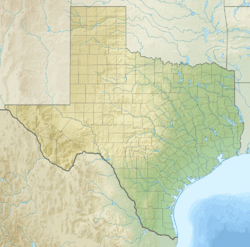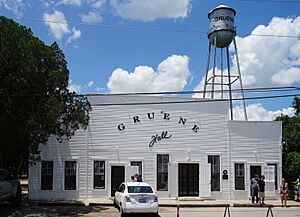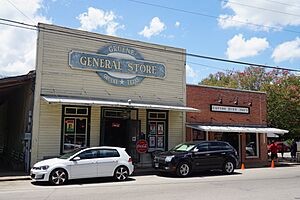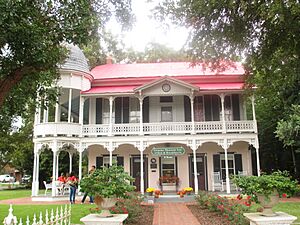Gruene, New Braunfels, Texas facts for kids
Quick facts for kids |
|
|
Gruene Historic District
|
|
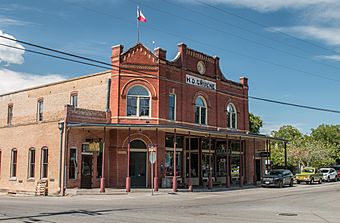
Gruene Historic District in 2018
|
|
| Location | Both sides of Sequin, New Braunfels, and Austin Sts., Gruene, Texas |
|---|---|
| Area | 25 acres (10 ha) |
| Built | 1850 |
| Built by | Christian Herry |
| Architectural style | Late Victorian |
| NRHP reference No. | 75001962 |
| Added to NRHP | April 21, 1975 |
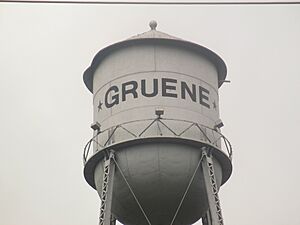
Gruene (/ˈɡriːn/ green) is a special German-Texan town in Comal County, Texas. It was once a big cotton-growing area along the Guadalupe River. Today, Gruene mostly relies on tourism for its economy.
Gruene is a German family name. The town is now part of New Braunfels. Many of its historic buildings were added to the National Register of Historic Places on April 21, 1975. The town is famous for its German-Texan history and unique buildings. Many people living there today are descendants of the first German settlers.
Contents
History of Gruene
How Gruene Started and Grew
German farmers first settled in Gruene in the mid-1840s. Ernst Gruene, a German immigrant, arrived in New Braunfels in 1845. Land was hard to find there. So, he and his two sons bought land along the Guadalupe River. Ernst built the first home in Gruene. It was made in a German timber-framing style called Fachwerk.
Ernst Gruene's second son, Heinrich (Henry) D. Gruene, built his own house. This house is now called the Gruene Family Home. Henry also planted cotton. Cotton was a very important crop. It brought about 30 families to work on Henry D.'s land. Henry D. built several buildings that are still standing today. These include his Victorian-style home (now Gruene Mansion Inn). He also built a Victorian cottage and a large brick home. A frame house for his farm manager (now Gruene Haus) was also built.
In 1878, Henry D. Gruene opened a store. It served the many families who were growing cotton on his land. The town was first called "Goodwin." It was on the stagecoach route between Austin and San Antonio. The store did very well for many years. It helped other businesses grow in the area. Soon after, a cotton gin was added. It used power from the Guadalupe River. This gin is now the Gristmill River Restaurant and Bar.
Gruene Hall opened in 1878. It is one of the oldest dance halls in Texas. The Thorn Hill School and three large cotton gins followed. By the 1880s, the International-Great Northern Railroad was built nearby. The small community was busy with businesses and farming. It officially became known as "Gruene." This name honored its founder and most important citizen.
Gruene's Decline and Becoming a Ghost Town
By 1900, Gruene was a major center. It had banks, cotton gins, and shipping for cotton farms. The community never had its own post office. But it did have two train stations by the 1910s. In 1922, the first cotton gin burned down. A new electric one was built nearby. It is now Adobe Verde.
However, Gruene faced big problems. A bug called the boll weevil ruined cotton crops in the 1920s. Then, the Great Depression made things even worse. The Great Depression was a time when many people lost their jobs and money was very scarce. By 1930, only 75 people lived in Gruene. After World War II, new highways were built that went around the town. By 1950, Gruene had become a ghost town.
How Gruene Came Back to Life
In 1974, a student named Chip Kaufman helped Gruene. He studied architecture at UT Austin. He worked to get Gruene listed on the National Register of Historic Places. He also looked for new owners for the old buildings.
Pat Molak was one of the new owners. He bought Gruene Hall in 1975. Pat and his friend Mary Jane Nalley bought and fixed up many of the town's famous buildings. They turned them into busy businesses. Mary Jane Nalley later received an award for her work.
Because of these efforts, Gruene started to come back to life in the early 1970s. The area continued to be rebuilt and restored through the 1970s and 1980s. Today, Gruene is no longer its own town. It became part of New Braunfels in 1979. But it has a very successful tourist business. Many of the original buildings from its busy past are still there. This includes the Gruene Family Home. It is a Victorian-style building from 1872. It is on the National Register of Historic Places. Today, it is the Gruene Mansion Inn. A historic water tower stands above Gruene Hall. Other buildings in the town center have been fixed up. They are now shops and restaurants. There is also a place where you can taste wine.
Important Buildings in Gruene
- Gruene Hall: This is a 6,000 square-foot, open-air dance hall. It is one of the oldest in Texas.
- Gruene Family Home: A historic Victorian-style house.
- Gruene Cotton Gin: The site of the original cotton gin, now a restaurant.


